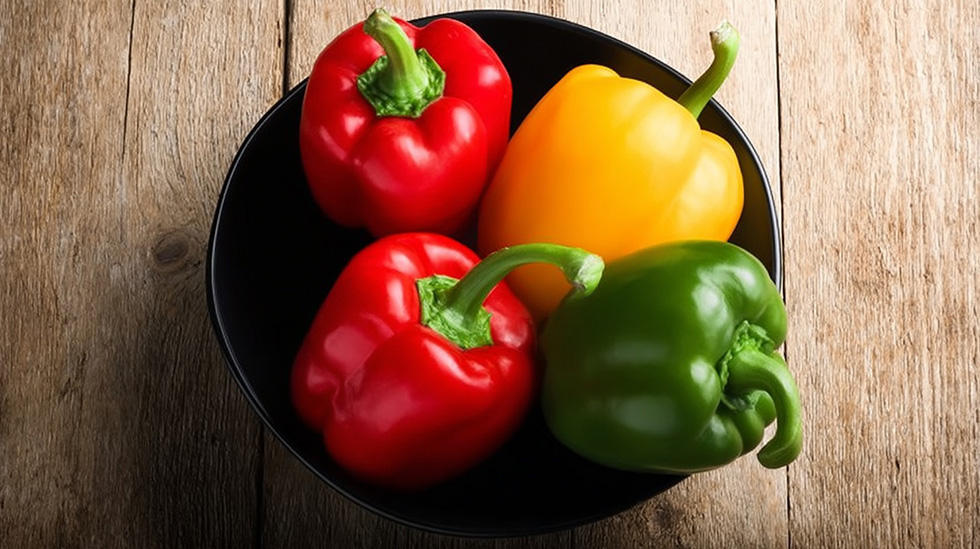Bell peppers – the vitamin bomb of colour
Bell peppers, or sweet bell peppers are a variety of the Capsicum annuum plant species. Its Latin name is the same as the other common peppers, but it is very unique in appearance and taste. It originated in Central and South America, from where it was brought to Europe by explorers in the 15th and 16th centuries – and has been around ever since.

The pepper family is very diverse, but the bell pepper is special in several ways:
- TV peppers: pale green in colour, thin fleshed, mild flavour – best when stuffed.
- Hot pointed peppers: oblong, hot, excellent for salads and stews, but beware, they are hot!
- Kapia peppers: sweet, red, flatter shape, perfect for grilling.
- Bell peppers: fleshy, thick-walled, sweet-tasting and come in many colours – red, yellow, green and sometimes orange.
Importance in the kitchen – 5/5
The bell pepper is a star in European and Hungarian cuisine. It is a vegetable that works perfectly raw, cooked, baked, grilled or even pickled. Its versatility, colour and sweet flavour make it a great addition to any dish – even if it’s just used as a garnish. No wonder it is becoming a staple in more and more households.
Which part is edible?
The edible part of the bell pepper is the flesh, which is the thick, juicy wall underneath the colourful skin. This is what we slice, stuff, roast and crisp.
The seed coat, seeds and green cup leaves (stems) are inedible parts, although not poisonous, they are bitter and unpalatable. The seeds can be planted, but the pepper will not be exactly like its ‘parent’ because they are hybrid varieties.
Health benefits and nutrients
Bell peppers are a vitamin bomb! 💪 Just one red bell pepper can provide several times the daily requirement of vitamin C – more than an orange. It’s also rich:
- Vitamin A – which is responsible for eye health;
- Vitamin B6 – which helps the nervous system to function;
- Folic acid – particularly important for pregnant women;
- Antioxidants – these help protect against cell damage.
According to traditional medicine, peppers strengthen the immune system, support the cardiovascular system and even aid digestion.
Growing and season
Bell peppers are mainly grown in greenhouses, as they are heat and light intensive. In the open air, it only grows well in very warm climates (e.g. southern Spain or Italy).
Spain is the largest producer in Europe, but the Netherlands, Italy and Poland are also major exporters. It is also grown in Hungary, mainly in greenhouses, typically from April to September.
It’ s available in shops all year round, but if you’re looking for Hungarian produce, the best time to get it is in the summer months – June to August. In winter, you’ll find almost exclusively imported goods.
How to choose good quality bell peppers?
Good bell peppers can be recognised by a few simple signs:
- The colour should be bright and clear – be it red, yellow or green, not faded or mottled.
- To the touch, it should be firm and firm, with a smooth and shiny skin.
- Avoid those that have soft spots, cracks or wrinkles – these are over-ripe or starting to deteriorate.
Storage tips
Bell peppers will keep for 5-7 days in the fridge, but be careful not to leave them in a humid environment as they can become mouldy. It’s best to store in a vegetable crate without plastic bags or paper bags to allow for ventilation.
If you cut it up, keep the leftovers in an airtight container and use them within 1-2 days.
Bell peppers in the kitchens of the world
This colourful vegetable is popular worldwide:
- Italian cuisine: the stewed vegetable ragout called peperonata is the star of the show;
- Mexican cuisine: used for fajitas, salsas and quesadillas;
- Chinese cuisine: it appears in meat and vegetable dishes cooked in a wok;
- Hungarian cuisine: stuffed, grilled, in lecsó or raw, it is also good in salads.
Emblematic recipe: stuffed bell peppers
A reimagining of the classic stuffed pepper with bell peppers – not only more spectacular, but sweeter and tastier too!
Basic recipe: wash the peppers, remove the seeds and stuff them with minced meat, cooked rice, garlic and herbs. Put them in the oven, drizzled with a little tomato sauce. Delicious!
Tips for use in the kitchen
Bell peppers are heavenly raw, but they show even more of their true colours when:
- bake in the oven – it will caramelise and become even sweeter;
- fry it quickly in a wok – it retains its crispiness and colour;
- grilled – it makes an excellent side dish or starter.
Spices that go with it: basil, rosemary, garlic, thyme, oregano, black pepper.
Spices to avoid: spices with too strong or bitter a flavour, such as marjoram or heavily smoked paprika – these will overpower the sweetness.
Cue
Bell peppers are not only beautiful and tasty, they’re also healthy – a real colour on your plate. Try it in different colours, shapes and dishes – it’s guaranteed to put a smile on your face and add colour to your kitchen! 🌶️🙂
